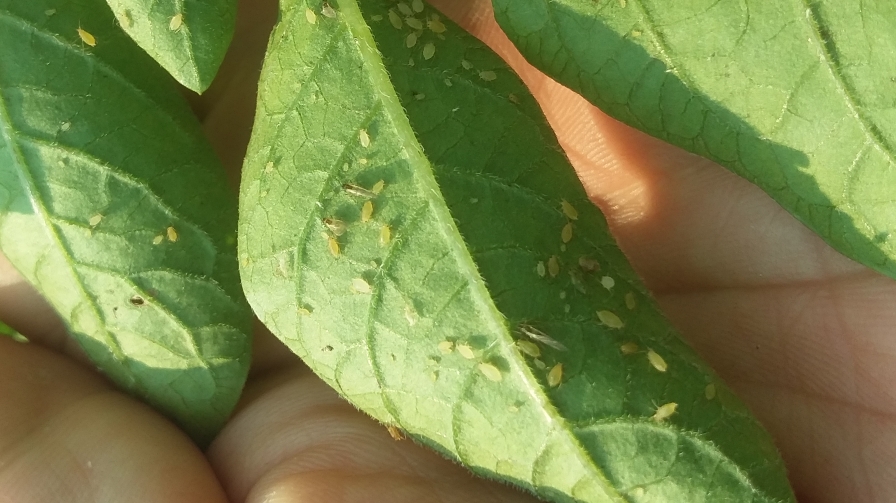Ways To Select and Apply the Right Insecticides in Potato Crops

Winged green peach aphids invade potato fields primarily early and late in the growing season. What’s the best way to handle them? Luckily, there are numerous insecticides for potato crops. Photo by Washington State University/J. T. Wohleb
Systemic insecticides are taken up by the roots or leaves and are translocated to other parts of the plant. They move upward from where they were first absorbed, but they don’t tend to move downward. There are a few exceptions, such as Movento [Bayer Crop Science] and Vydate [Corteva], which are fully systemic and can move up to the leaves and down to the roots. Neonicotinoids (Group 4A) are a widely used class of systemic insecticides (e.g., Admire Pro [Bayer Crop Science], Actara, Cruiser, Platinum [Syngenta]).
Contact insecticides stick to plant surfaces and don’t get absorbed into the plant. Pyrethroids and organic pyrethrins (Groups 3 and 3A) are contact insecticides (e.g., Asana and PyGanic [Valent], Mustang [FMC], Warrior [Syngenta]. Some other contact insecticides used on potatoes are Aza-Direct and Imidan [Gowan], Lannate [Corteva], Rimon [UPL], Torac [Nichino America].
Translaminar insecticides penetrate leaf tissues but don’t move within the plant’s vascular system. Spinosyns (Group 5) are widely used translaminar insecticides (e.g., Blackhawk, Delegate, Entrust, Radiant [Corteva]). Other translaminar insecticides used on potatoes are Agri-Mek and Fulfill [Syngenta], Carbine [FMC], Sefina [BASF].
Systemic and translaminar insecticides can be useful for controlling insects found mainly on the underside of leaves, like aphids and potato psyllid nymphs, where contact insecticides may not adequately distribute. The ability of systemic insecticides to move to new leaves can be an advantage over contact and translaminar insecticides that must be reapplied to protect new growth.
Coverage is an important consideration for any insecticide, and it’s essential for contact and translaminar insecticides. Pay attention to use directions relating to coverage, such as recommended methods of application, amount of water to use for application, and inclusion of adjuvants (stickers, spreaders, or penetrators).
Residual activity: Systemic insecticides applied to the seed, or to the soil at planting, or at hilling can provide a month or two of residual activity (e.g., Admire Pro [Bayer Crop Science], Belay [Valent], Cruiser, Platinum). They can be useful when targeting pests that migrate into potato fields over an extended period (e.g., aphids, Colorado potato beetles, leafhoppers, and potato psyllids) because fewer follow-up applications are needed. Systemic insecticides applied to foliage have shorter residuals, but it depends on the product. Movento can be expected to last up to three weeks, while Dimethoate [FMC] lasts only days.
Most pyrethroid insecticides can persist on leaf surfaces for seven to 14 days (e.g., Asana, Mustang, Warrior), but organic pyrethrins degrade rapidly (e.g., PyGanic). The spray solution for pyrethrins should be buffered to pH 5.5-7.0 and applied late in the day, because pyrethrins are subject to alkaline hydrolysis and are UV sensitive. It’s important to pay attention to buffering requirements for insecticides. Many break down rapidly in alkaline solution (e.g., Exirel [FMC], Lannate, Vydate). There are others, like spinosyns (e.g., Blackhawk, Delegate, Entrust, Radiant), that degrade more rapidly in acid solution.
Fast-acting products: Lannate is used to quickly knock down established pest populations before they cause extensive damage. However, it can be a poor choice if your goal is to control diseases spread by insects as they migrate into potato fields. Lannate residues last only a few days, so insect vectors that move into the field after that can survive to spread the disease unless another insecticide is applied.
Some insecticides have rapid anti-feeding activity (e.g., Exirel, Fulfill, Sivanto [Bayer Crop Science]). Targeted insects stop feeding in a matter of hours, but it can take days for them to die. These products help to control pathogens that spread quickly when their insect vectors move from plant to plant (e.g., Potato Virus Y). Other insecticides may kill the insects too slowly to prevent disease transmission and spread, especially when the insects enter the field in large numbers that drive them to spread out.
EFFECTS ON NON-TARGET INSECTS
The relative impact of insecticides on non-target insects, like pollinators and predators, depends on their selectivity, toxicity, and duration of impact.
Systemic insecticides work mainly via ingestion, so they are considered relatively soft on insects that feed mainly on other insects, but they can have undesirable effects on pollinators that feed on insecticide-infused nectar or pollen.
However, these detrimental effects may be less concerning for potatoes, since potato flowers don’t produce nectar and most commercial varieties produce very little pollen. Nonetheless, you should always heed pollinator precautions when applying insecticides.
Rimon is a selective contact insecticide that controls juveniles by disrupting the molting process. It doesn’t control adults. Also, it must be ingested by larvae and nymphs to kill them. These characteristics make it softer on pollinators and predators. Avaunt, Aza-Direct, Carbine, Sefina, spinosyns (e.g., Blackhawk, Delegate, Entrust, Radiant), and diamides (e.g., Exirel, Harvanta, and Vantacor) are also considered selective insecticides.
Contact insecticides with broad-spectrum activity and persistent residues, like pyrethroids (e.g., Asana, Mustang, Warrior), can be hard on non-target insects. Their use can lead to outbreaks of pests like aphids, psyllids, and thrips that are often kept in check by predator insects. These products should be avoided mid-season when consequent pest outbreaks can be most detrimental.
Disclaimer: Application of a pesticide to a crop or site that is not on the label is a violation of pesticide law and may subject the applicator to civil penalties. It is your responsibility to ensure lawful use and obtain all necessary permits in advance of application.










